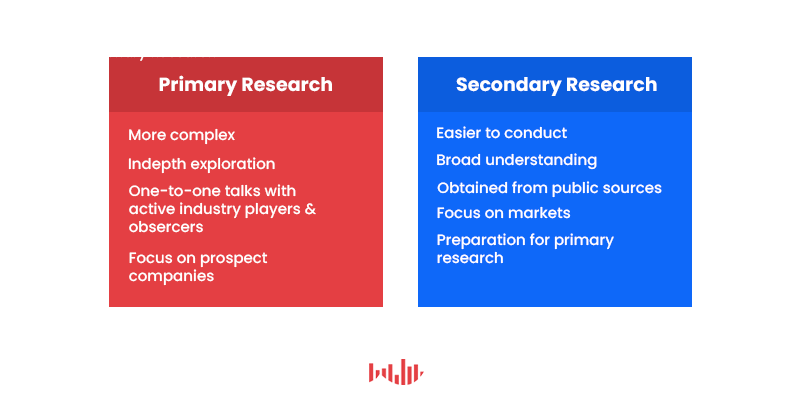How To Run Market Research For Your Startup

Market research is a vital component of any business; it is especially indispensable for startups, which are notorious for carrying many risks. For instance, startups have a dismal rate of failure in 2020: a heaping 90% of new startups fail. Unfortunately, this is but one of the many other grim statistics these companies face.
Luckily, startup companies that conduct market research have a major leg up in their field. That’s because market research is a wide-spanning strategy that allows businesses to glean an array of insights. This includes findings on their competitors, customers, potential customers and the sector/niche at large.
In this article, you’re going to learn how to run startup market research for your company to stay ahead of the game and preempt failure.
Where to Begin on Market Research for Startups
Given that market research is an umbrella term, it’s common to be uncertain as to where to begin. It may seem that with market research websites, tech platforms and the mighty Internet itself, market research is information overload. It’s just another headache-inducing task that will produce few results.
That’s where you’re wrong.
Knowing where to start conducting a viable market research plan is key to garnering essential business knowledge, and the results can make or break your startup.
The first undertaking of doing market research is, well, discovering if there’s a market for your product or service. Many entrepreneurs evade this critical first step, as it may seem too obvious.
Or, you may feel a tad too complacent with your offering, deeming it abundantly innovative or useful, so much so that it doesn’t need to identify a market to which it belongs.
That’s a major misstep. You must always first identify the market you belong to. Only thereafter, can you determine your precise target market and continue with your market research. Most importantly, the market you identify can help you learn if your product or service is in demand. If you have too niche of a market, you will want to amplify your marketing efforts to bring more awareness to your niche and increase its profit-reaping potential.
Understanding Your Market
Once you’ve identified which market your product or service falls under and whether it’s worthy to branch into, you’re going to need to have a solid grasp on your market. This is not a “one and done” task, as market trends and marketing strategies across markets evolve with the times. Sometimes these changes occur in a matter of days.
Understanding your market, or more specifically, your niche, will help catapult you towards success. This is the bulk of market research and it involves relying on a swath of different sources.

There are two types of sources to observe in your market and niche, and in market research as a whole: primary and secondary sources.
Primary research
is research that you generate yourself, usually directly from the customers. This type of firsthand information is crucial for understanding your buyer personas and segmenting your target market. We’ll analyze primary research later in the article.
Secondary research
is the research that’s already been generated from a variety of sources and made available on the internet, trade magazines and other literature.
For the purpose of understanding your market, niche and competitors, we’re going to focus on secondary research.
You ought to accumulate as much secondary information as possible if you want a clear picture of your market. Here are the secondary sources you should turn to when running your market research on your market itself:
- For the latest trends within your market/niche, obtain trend reports from credible sources such as Google Alerts, Google Trends and Keyhole. These are keyword-based tools that can help you identify trends via:
- Finding the latest blogs, news, videos and search terms for free (Google Alerts)
- Monitoring search terms and drawing data on users searching for the terms for free (Google Trends).
- Overlooking keywords, topics, social media handles, URLs and mentions for a fixed price.
- Next, gather all the necessary statistics on typical personas within the market, buying habits, conversion rates and more.
- US Census Bureau and the US Bureau of Labor Statistics (public market data)
- Research agencies: Pew, Forrester and Gartner for a wide span of market reports
- Industry content sites (news and blog sites particular to a niche. Ex: Ars Technica for tech and IT; Mashable for tech, culture, science; Product Hunt for sharing and discovering new products; etc.)
- Then, study your competitors closely.
- Identify direct and indirect competitors:
- Direct competitors: Businesses with products/services that closely resemble your own and can substitute yours.
- Indirect competitors: Businesses with relatively similar products/services, but cannot fully substitute one another.
- Find the potential weaknesses in your competitors’ offerings, or learn how to use their strengths to improve your own.
- Parse through their websites to understand their pricing, customers and content.
- Research their sales channels and social media.
- Use specific tools for competitor analysis (SEMRush, Nielsen, Klue.com, etc.)
- Finally, store all the findings on your market (the specific niche, and competitors) into an organized and comprehensive document such as a presentation for current and ongoing reference. This is going to be your market knowledge base.
Understanding Your Customers and Potential Customers

Now that you have aggregated a slew of research within your industry and competitors, it’s time to do a deeper delve into your market research. This latter stage is all about your customers: current customs, those in a nurturing stage and all other potential customers.
That’s where primary sources come largely into play. We’ve covered secondary sources and how they can help you research your overall market, but now, it’s time to understand your target market.
A target market is a group of people that a company targets as the primary buyers of their product/service. This is the group on whom a company focuses all of its marketing initiatives. This is the main group of a market, as it is the one most likely to make purchases and become loyal customers.
There are two types of primary sources: exploratory primary sources and specific primary sources. Both of these are necessary to render a clear understanding of your target market.
Here is how to continue your market research by investigating your target market:
- Preface the makeup of your target market via the secondary research you’ve conducted in the first half of the article. This will give you a general sense of who your target market is.
- To fully understand your target market, switch to primary sources to understand the full scope of your target market and cater to them the right way.
- Run exploratory primary research on your target market. This involves conducting:
- open-ended interviews over the phone or in-person
- surveys with a small amount of respondents
- surveys that cover the entirety of your target market
- Run exploratory primary research on your target market. This involves conducting:
3. Identify issues and potential opportunities to study within your target market.
4. Use these topics to narrow into the specifics of your target market with specific primary sources.
- Create surveys that focus on specific segments of your target market.
- Focus on questions aimed at solving points of friction or problems
Closing Up on Setting Market Research in Motion
Aside from understanding your customers’ preferences, needs and problems, it is of utmost importance to first understand them from a demographics perspective. As highlighted in Step 1, you can gather some qualities about your target market from secondary sources. But it’s only a primer and far from giving you the full picture.
Surveys, on the other hand, give startups a major advantage over secondary data and even other primary sources such as focus groups. This is because you control all the questions you collect on your subjects. This includes demographics data such as age, location, gender, education and income level, ethnic background, marital status and more.
A twofold market research tool, surveys also grant you access into the minds of your target audience. Again, this is because you are in control of conceiving all the questions about your target market.
Understanding what in particular your customers’ desire and how they generally think will empower your market research efforts and business in general to stay ahead of the curve. It will assure that you know how to properly market to your customers.
Frequently asked questions
Why is market research important for startups?
Market research can help a startup avoid failure by providing an in-depth view of the market, including potential customers, competitors, and their sector in general. Market research can help prevent failure and ensure that startup funds are used wisely.
What is the first step in market research for startups?
The first step is to identify the precise market that the startup wants to target. By understanding the target market, the company can determine if there is sufficient demand for their product or service.
What is a target market?
The group of consumers who are most likely to buy a company’s products or services is referred to as the target market. While there may be customers outside of this group, the target market contains those people who are most likely to become loyal customers.
What are the two methods of research used in market research?
Primary research and secondary research are the two components of market research. Primary research focuses on gathering first-hand information via research panels, surveys, focus groups, etc. Secondary research makes use of existing, published information such as white papers, industry journals, and government statistics sites.
What advantages do surveys have for startups?
Not only do surveys provide the responses to the specific questions that a business needs answers to, but they can also be used to gather a wealth of demographic data. Since startups are often operating in areas where there is less secondary research available, the collection of demographic data can provide information that would otherwise be difficult to obtain.
Pollfish Marketing Team
Ready to Try Pollfish?
Create your survey with AI, target high-quality respondents starting at $0.95 per complete, and start getting results in just minutes in real-time. From running a simple product concept survey to managing a constant stream of trackers for dozens of clients in dozens of countries, we’ve got you.
